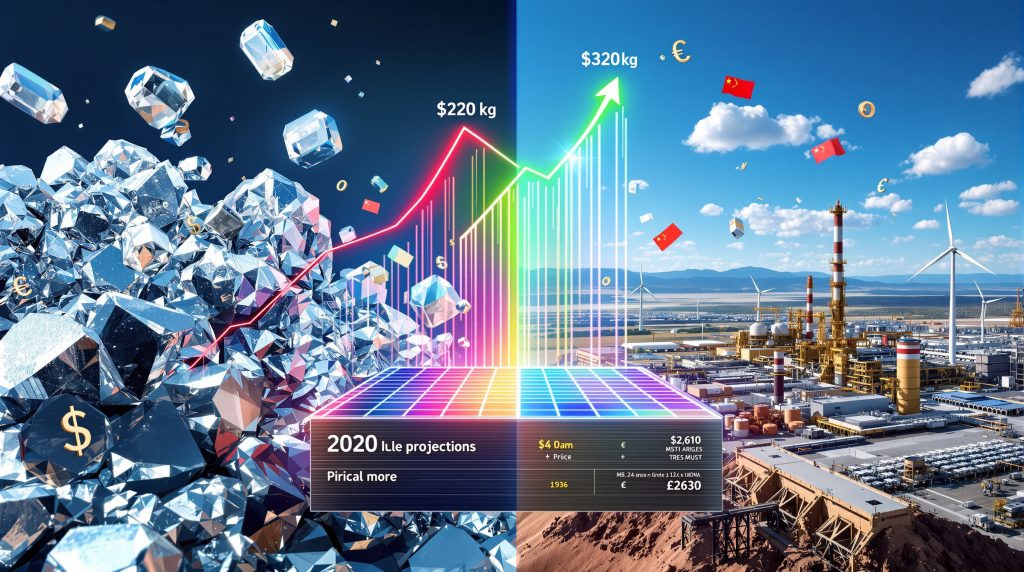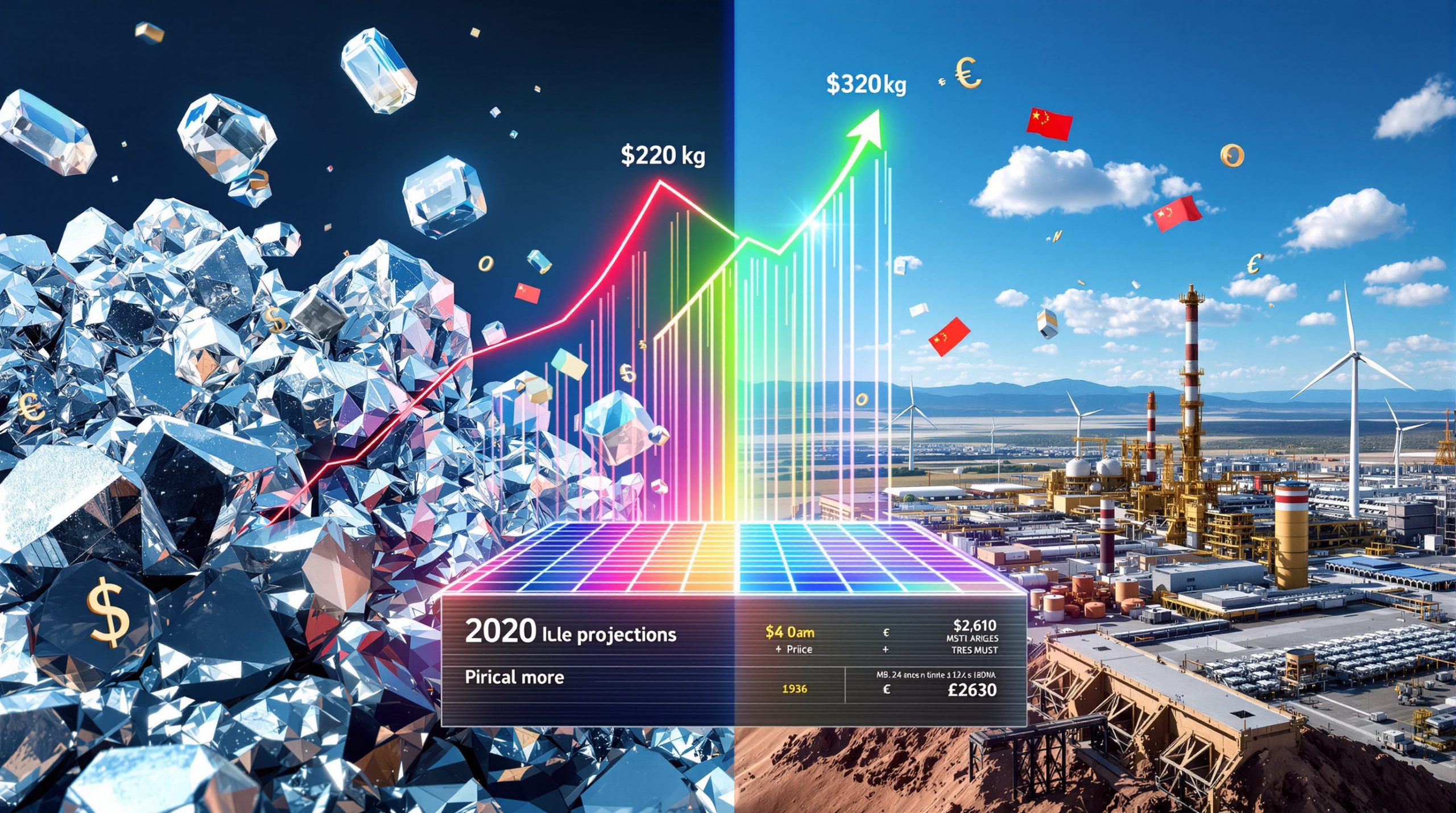The rare earth yttrium price surge has fundamentally altered global supply chains as traditional mining economics undergo unprecedented transformation. Industrial metals that once traded as commodity inputs now command strategic premium pricing, reflecting their critical role in energy transition technologies and defence applications. This structural shift represents more than temporary market volatility – it signals a permanent recalibration of how nations and industries value access to essential materials for technological advancement.
Understanding Yttrium's Market Revolution
The rare earth element yttrium has emerged from relative obscurity to become one of 2025's most dramatically repriced industrial materials. This silvery-white, moderately soft metal has witnessed price movements that challenge conventional commodity market analysis, with European market quotations surging from approximately $6 per kilogram at the start of 2025 to a current trading range of $220-$320 per kilogram by November.
This represents an extraordinary price increase of 3,567% to 5,233%, depending on specific contract terms and delivery locations. The substantial spread between current pricing levels reflects the chaotic nature of supply allocation, with market participants operating under vastly different contractual arrangements established before the shortage became apparent.
Supply Constraint Dynamics
The rare earth yttrium price surge has revealed the extensive integration of this element across civilian high-technology and defence applications. Unlike temporary commodity price spikes driven by speculative trading, this disruption stems from structural supply-demand imbalances that have accumulated over multiple years of underinvestment in rare earth processing capacity.
Market pricing volatility between $220-$320 per kilogram reflects differing contract structures rather than normal price discovery mechanisms. Some industrial consumers locked into legacy supply agreements continue receiving material at significantly lower prices, while spot market participants face the full impact of shortage conditions.
Furthermore, this situation exemplifies the broader challenges within rare earth reserves distribution, where concentrated processing capacity has created strategic vulnerabilities.
Industrial Demand Acceleration
Yttrium's applications span critical technology sectors including:
• Aerospace manufacturing requiring specialised alloy components
• Semiconductor production utilising high-purity yttrium compounds
• Energy infrastructure incorporating yttrium-based materials in advanced systems
• Defence technologies dependent on yttrium's unique metallurgical properties
These end-use sectors demonstrate relatively inelastic demand, meaning price increases have minimal impact on consumption patterns in the short term. Industrial consumers require yttrium for essential manufacturing processes where material substitution involves lengthy qualification procedures and significant technical risks.
Strategic Mining Project Economics Transformation
The rare earth yttrium price surge has fundamentally altered the economic viability of previously marginal rare earth projects worldwide. South Africa's Phalaborwa rare earths project exemplifies how dramatic pricing changes can transform project economics and accelerate development timelines.
Additionally, this transformation directly impacts the broader critical minerals energy transition as nations scramble to secure reliable supply chains for essential materials.
Phalaborwa Project Case Study
Rainbow Rare Earths' Phalaborwa project in Limpopo province represents a pioneering approach to rare earth recovery from phosphogypsum waste streams. This innovative processing method leverages over 60 years of accumulated phosphate mining byproducts from Foskor's operations.
Key Project Metrics:
| Parameter | Value |
|---|---|
| Annual Yttrium Oxide Production | 213 tonnes |
| Total Magnet REE Production | ~1,900 tonnes annually |
| Upfront Capital Requirement | $326.1 million |
| Project Life | 16 years |
| Phosphogypsum Processing Capacity | 2.2 million tonnes annually |
| Magnet REE Recovery Rate | 65% |
Economic Impact Analysis
The inclusion of yttrium in Phalaborwa's SEG+ (Samarium, Europium, Gadolinium plus other elements) product basket adds an estimated $30 million annually to project EBITDA at conservative European pricing levels. This represents a substantial earnings enhancement with no additional production costs, as yttrium recovery occurs as part of the integrated rare earth processing flowsheet.
George Bennett, CEO of Rainbow Rare Earths, emphasised that yttrium price increases positively impact estimated annual EBITDA for Phalaborwa since no extra costs are required to produce it as part of the proposed SEG+ product mix.
Processing Innovation Advantages
Phalaborwa's competitive advantages include:
• Abundant feedstock supply from decades of phosphate processing waste
• Low-capital intensity compared to conventional rare earth mining
• Near-term production timeline with expected startup in 2026
• Integrated processing approach recovering multiple rare earth elements simultaneously
• Established infrastructure leveraging existing industrial facilities
The project represents the first commercial-scale recovery of rare earth elements from phosphogypsum, positioning Rainbow Rare Earths as a technological pioneer in alternative feedstock processing.
Advanced Processing Technologies and Market Position
The development of Phalaborwa's processing capabilities demonstrates sophisticated rare earth separation and purification technologies. The project's large-scale pilot plant operation provided critical validation of technical and economic assumptions underlying commercial development decisions.
Pilot Plant Validation Results
Rainbow Rare Earths conducted extensive pilot testing through collaboration with South Africa's state-owned Mintek research organisation. The pilot plant operated at 20 kilograms per hour of feed rate, representing 6 to 10 times the scale of typical pilot operations.
Technical Partnerships:
• Ansto Minerals: Plant processing test work and flowsheet development
• K-Tech: REO separation technology and back-end processing at U.S. facilities
• Mintek: Front-end processing management in South Africa
• METC Engineering: Economic studies and definitive feasibility work
Product Specifications and Market Applications
The SEG+ product represents a high-purity mixed rare earth concentrate containing all economically important medium and heavy rare earth elements. This foundational material enables downstream separation and refinement into specialised compounds used in:
• Permanent magnets for wind turbines and electric vehicles
• Electronics manufacturing requiring high-purity rare earth inputs
• Advanced materials for aerospace and defence applications
• Energy storage systems utilising rare earth-enhanced components
Global Supply Chain Restructuring Implications
The rare earth yttrium price surge reflects broader geopolitical and economic forces reshaping global rare earth supply chains. Traditional concentration of processing capacity in specific geographic regions has created strategic vulnerabilities that industrial consumers and governments are now actively addressing.
Consequently, this situation has accelerated the mining industry evolution as companies adapt to new supply chain realities.
Strategic Mineral Classification Impact
The recognition of yttrium and other rare earths as strategic materials has triggered policy responses across multiple countries. National security considerations now influence supply chain decisions previously driven purely by economic factors.
Industrial consumers face several challenges:
• Supply security concerns regarding single-source dependencies
• Price volatility management in long-term procurement planning
• Technology qualification requirements for alternative suppliers
• Inventory strategy optimisation balancing cost and availability risks
Regional Development Opportunities
The current supply shortage has accelerated development timelines for rare earth projects across multiple continents. Projects previously considered economically marginal now demonstrate attractive returns at elevated pricing levels.
African rare earth development, exemplified by the Phalaborwa project, benefits from:
• Diverse geological resources spanning multiple rare earth elements
• Lower labour and infrastructure costs compared to developed markets
• Government support for strategic mineral development
• Proximity to growing industrial markets in emerging economies
Investment Analysis and Risk Assessment
The transformation of yttrium from a specialty material to a strategic commodity presents both opportunities and risks for investment portfolios. Traditional commodity investment frameworks require modification to account for geopolitical premiums and supply security considerations.
However, understanding the broader critical minerals strategy context is essential for investors navigating this transformed landscape.
Project Risk Factors
Technical Risks:
• Processing technology scalability from pilot to commercial operations
• Product quality consistency meeting industrial specifications
• Equipment reliability in continuous processing environments
Market Risks:
• Price volatility impacting long-term project economics
• Demand substitution through alternative materials development
• End-use sector consumption pattern changes
Operational Risks:
• Feedstock availability and quality variability
• Regulatory compliance in multiple jurisdictions
• Infrastructure development and maintenance requirements
Financial Performance Metrics
Phalaborwa's updated economic study demonstrates improved confidence levels compared to preliminary assessments. The $326.1 million upfront capital requirement, while substantial, reflects comprehensive engineering work and detailed cost estimation.
Key Financial Indicators:
• Capital efficiency through utilisation of existing phosphate processing infrastructure
• Operating leverage from fixed-cost processing operations
• Revenue diversification across multiple rare earth products
• Margin stability through long-term offtake arrangements
What Factors Are Driving Long-Term Price Stabilisation?
The rare earth yttrium price surge stabilisation depends on successful expansion of global processing capacity and potential demand moderation through technological substitution. The timeline for supply-demand rebalancing extends beyond typical commodity cycles due to the complexity of rare earth separation and purification processes.
Supply Response Timeline
New rare earth processing capacity requires 2-4 years for development from project approval to commercial production. This extended lead time ensures continued tight supply conditions through the mid-2020s, even with accelerated project development schedules.
Critical Milestones:
• 2026: Phalaborwa project commercial production startup
• 2027-2028: Additional African projects reaching production
• 2028-2030: Potential supply-demand rebalancing
Demand Evolution Factors
Long-term yttrium demand growth drivers include:
• Energy transition acceleration increasing permanent magnet requirements
• Defence technology advancement utilising specialised rare earth alloys
• Semiconductor industry expansion driving high-purity material demand
• Emerging applications in quantum computing and advanced materials
Investment Strategy Considerations
The yttrium market transformation requires sophisticated portfolio allocation strategies that balance opportunity capture with risk management. Traditional commodity exposure methods may inadequately address the unique characteristics of strategic mineral markets.
For instance, many countries are developing their own critical minerals reserve to ensure supply security.
Sector Allocation Approaches
Direct Mining Exposure:
• Equity positions in rare earth development companies
• Focus on projects with near-term production potential
• Geographic diversification across multiple supply regions
Value Chain Integration:
• Downstream processing and separation capabilities
• Technology partnerships and licensing arrangements
• End-use sector exposure through industrial consumers
Risk Management Strategies:
• Currency hedging for international operations
• Contract structure optimisation for price and volume risks
• Regulatory compliance and government relations management
Technological Innovation and Future Developments
The current supply shortage has accelerated research into alternative processing technologies and material substitution possibilities. These developments may influence long-term market dynamics and competitive positioning among suppliers.
Processing Efficiency Improvements
Advanced separation technologies offer potential for:
• Higher recovery rates from existing feedstock sources
• Reduced processing costs through energy optimisation
• Improved purity levels meeting evolving industrial specifications
• Waste minimisation addressing environmental concerns
Alternative Feedstock Development
Beyond conventional mining approaches, alternative sources include:
• Recycling systems for end-of-life rare earth products
• Industrial byproduct recovery from various manufacturing processes
• Ocean-based resources requiring advanced extraction technologies
• Urban mining from electronic waste streams
The success of phosphogypsum processing at Phalaborwa demonstrates the viability of unconventional feedstock sources, potentially inspiring similar developments at other phosphate mining operations globally.
Regulatory Environment and Policy Implications
Government policies regarding strategic minerals significantly influence market dynamics and investment decisions. The classification of yttrium as a critical material has triggered various policy responses designed to enhance supply security.
National Security Considerations
Strategic mineral policies typically address:
• Domestic processing capacity development incentives
• Supply chain diversification requirements for defence contractors
• Technology transfer restrictions and export controls
• Emergency stockpiling programmes for critical materials
These policies create both opportunities and constraints for market participants, influencing project development timelines and market access conditions.
How Should Investors Model Price Evolution Scenarios?
Understanding potential price evolution requires comprehensive scenario analysis incorporating supply additions, demand growth, and policy interventions. Multiple factors interact to determine market equilibrium conditions over extended time horizons.
Base Case Scenario Assumptions
Supply Factors:
• Phalaborwa and similar projects achieving planned production levels
• Moderate expansion of existing processing operations
• Technology improvements enhancing recovery efficiency
Demand Factors:
• Continued growth in energy transition applications
• Stable defence and aerospace sector consumption
• Limited successful material substitution
Price Implications:
• Gradual price moderation from current peak levels
• Sustained premium to historical pricing
• Periodic volatility around long-term trend
Risk Scenario Considerations
Upside Risks:
• Slower than expected supply response
• Accelerated demand growth from new applications
• Geopolitical supply disruptions
Downside Risks:
• Successful large-scale substitution technologies
• Economic slowdown reducing industrial demand
• Rapid capacity additions causing oversupply
According to the Financial Review, "this crazy price surge shows why the US wants control of rare earths", highlighting the geopolitical dimensions of current market conditions.
Furthermore, as reported by Mining.com, "yttrium price surges to record as rally approaches 1,500%", confirming the extraordinary magnitude of this market transformation.
Disclaimer: This analysis contains forward-looking statements and market projections that involve significant uncertainties. Actual market conditions may differ materially from the scenarios discussed. Investment decisions should consider comprehensive risk assessment and professional financial advice.
Conclusion: Strategic Positioning in the New Paradigm
The yttrium market transformation represents a fundamental shift in how strategic materials are valued and allocated across the global economy. This change extends beyond simple price adjustments to encompass supply chain restructuring, investment prioritisation, and policy framework evolution.
For market participants, success requires adaptation to new competitive dynamics where supply security considerations often outweigh traditional cost optimisation approaches. The Phalaborwa project demonstrates how innovative processing technologies and strategic positioning can capture value from these structural market changes.
The broader implications extend to energy transition timelines, defence capability maintenance, and technological competitiveness across multiple sectors. Understanding these interconnections provides essential context for navigating the evolving landscape of critical mineral markets.
Long-term value creation will likely favour participants who combine technical innovation, strategic feedstock access, and sophisticated risk management capabilities. The current market disruption, while challenging for industrial consumers, creates opportunities for well-positioned suppliers to establish sustainable competitive advantages in this transformed economic environment.
Ready to Capitalise on Strategic Mineral Discoveries?
Discovery Alert's proprietary Discovery IQ model delivers real-time alerts on significant ASX mineral discoveries, instantly empowering subscribers to identify actionable opportunities ahead of the broader market. Understand why historic discoveries can generate substantial returns by exploring Discovery Alert's discoveries page and begin your 30-day free trial today to position yourself ahead of the market.




